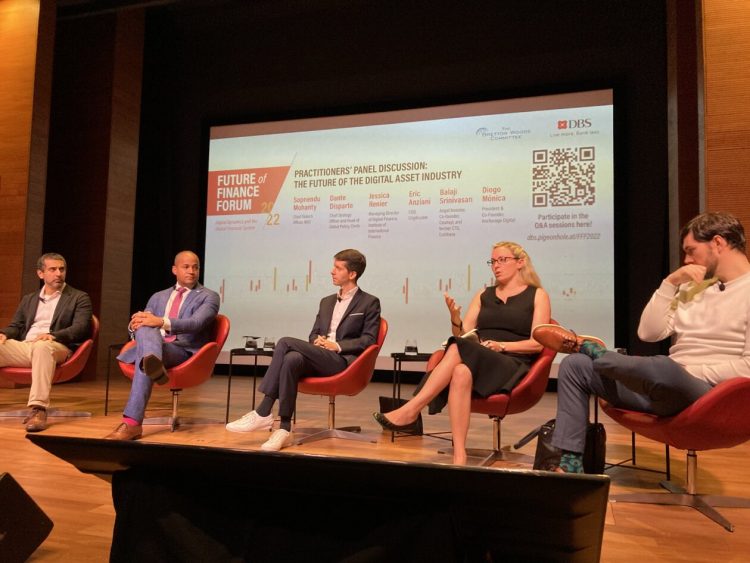The deputy chief of India’s central bank took aim at stablecoins during a finance conference in Singapore on Monday, describing them as wholly replaceable by central bank digital currencies (CBDCs).
“There’s no use case that private digital currency can provide that fiat digital currency cannot,” Reserve Bank of India Deputy Governor T. Rabi Sankar told attendees at the Future of Finance Forum, organized by the Bretton Woods Committee and Singapore-headquartered DBS Bank.
Sankar’s remark drew a robust defense of stablecoins and other non-state digital currencies from digital asset industry speakers at the event, who criticized CBDCs on a number of fronts and questioned Sankar’s characterization of private money.
“I don’t think there is a boundary between responsible private sector-issued money, or digital currency, and public money,” Dante Disparte, stablecoin issuer Circle’s chief strategy officer and head of global policy, told conference attendees. “Public blockchain infrastructure is an improvement on financial markets infrastructure pre-2008, which was closed and proprietary and fundamentally vulnerable. So, I reject the categorization that the only type of money that can be trusted is publicly issued.”
“Ninety-five percent of all value-added money in circulation today, on the planet, period — domestic, cross-border, global — is privately issued,” he said.
On-chain and public
Diogo Monica, president and co-founder of digital asset platform and infrastructure provider Anchorage Digital, went a step further. Taking the example of the world’s oldest cryptocurrency, he said: “Bitcoin is truly public money … It is truly decentralized, globally accessible money. It does not fit at all in the category of private. We don’t know who created it. There’s no one entity running it. We cannot call it private.”
“I have not seen any CBDC that actually has the characteristics that have given stablecoins a product market fit,” he said. “I think it’s very reductive to try to make these the same thing, because they are not substitutes for one another at all. They might be competitors, but they are not substitutes.”
Disparte said around half of the world’s population lived in countries whose fiat currencies were being eroded by hyperinflation, and Balaji Srinivasan, cofounder of genetic testing company Counsyl and a former chief technical officer at crypto exchange Coinbase, said crypto had represented a relative safe haven in nations such as Lebanon and Venezuela, where inflation had raged out of control and rendered non-crypto savings worthless.
“You can best think of Bitcoin and cryptocurrency, and internet encryption more generally, as global government departments, something that enshrines human rights and property rights of citizens around the world – even when their governments are adverse or hostile or even totalitarian – against instances of hyperinflation,” he said.
Framing the issue also in terms of privacy, he said: “We know that there are countries that are building surveillance currencies,” while not naming any individual nations.
Disparte said: “The second a central bank crosses the line – the marginal line of the ‘air gap’ between the central bank, your wallet, and how you spend your money, I think the temptations are far too great to introduce a form of money that has an enormous amount of societal risks – so much so that I would label them as anti-democratic.”
Price, power and a paradox
Srinivasan warned that the issuance of CBDCs could put pressure on the value of currencies, saying: “If [countries] actually do CBDCs, they all get put into the DeFi (decentralized finance) matrix, which is every asset versus every asset at all times. And so, every currency is competing for its bread … and nobody wants to hold any but the very, very best assets. A lot of these CBDCs, once digitized, will face that issue.
“So that’s also a disincentive to do this, if you don’t actually increase the strength of these countries’ control of the population but decrease it.”
Sankar argued, however, that the proliferation of stablecoins, particularly those linked to reserve currencies such as the U.S dollar, would rob countries such as India of control of their monetary policy.
“The fear we have, if, for example, we allow a stablecoin linked to the dollar in India, [the economy] will get dollarized,” he said. “We have a monetary policy, we have a method of implementing policy, economic policy, and we can’t really give all that up.”
William Dudley, chair of the Bretton Wood Committee and a former president of the Federal Reserve Bank of New York, said that CBDCs might eclipse stablecoins if they were sufficiently developed.
“Stablecoins are interesting because they could ultimately just be transitional,” he said. “If central bank digital currencies develop and have the right technology behind them … if a central bank digital currency is able to bridge the new ecosystem, then why do I need a stablecoin in addition to it? So, stablecoins could ultimately be transitional rather than lasting.”
Sankar also addressed concerns over privacy issues related to CBDCs, saying that India’s digital rupee, trials of which began this month, would be “as close to physical cash as possible as technologically possible.”
“We want it to be exactly as anonymous as physical cash,” he said. “That’s not very easy when it’s digital … [but] legally we can make that possible.”
Innovation impact
Monica said that whatever form they took, CBDCs could have the effect of stifling innovation in the digital asset space.
“If you’re pushing all innovation to happen with CBDCs, you essentially end up with this weird problem that’s effectively the money equivalent to the Overton window,” he said, referring to a concept describing a range of policies that are politically acceptable to the bulk of a population at any given time and which could lead to risk-averse mediocrity.
“Every single innovation is within the window, and there’s no pushing the boundaries,” he said. “A lot of the things that exist today that are great things are happening a little bit outside to the left or a little bit outside to the right [of that window].”
Disparte said innovation had to be protected, reminding conference attendees that even traditional coins and banknotes had once been cutting-edge.
“If you went to a regulator today with an innovation called cash, it’s not likely – given today’s regulatory standards – that it would be approved, because it’s backward looking,” he said. “It’s a haven for corruption, bribery and fraud, and, in the context of a public health emergency like Covid-19, it’s a vector for spreading disease.”
He said he didn’t want to see stablecoins and CBDCs positioned as rivals, but warned: “If central banks don’t keep up, they’re going to be made irrelevant.”
Source by forkast.news






























